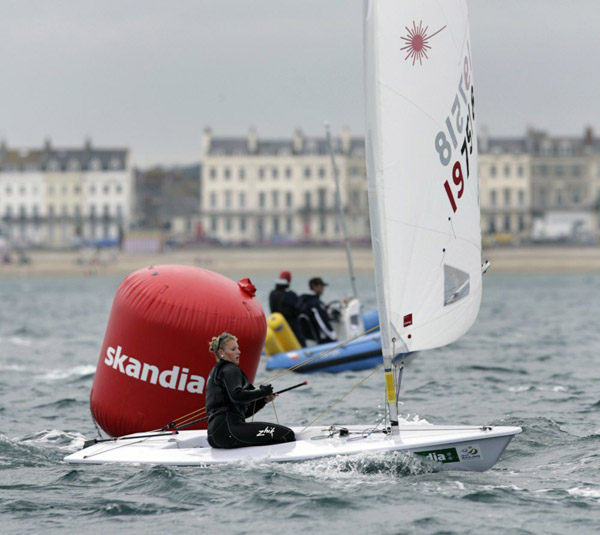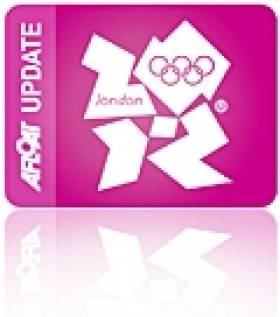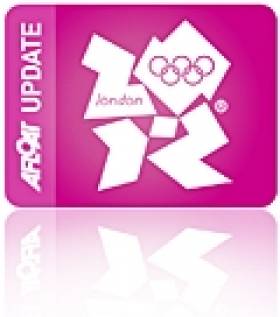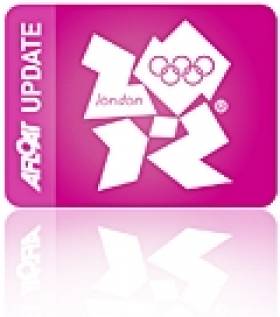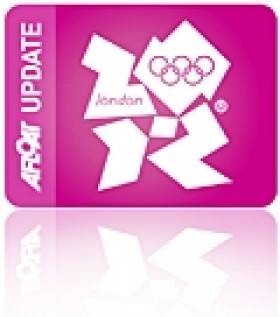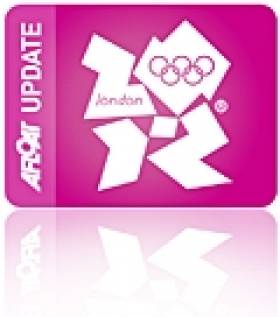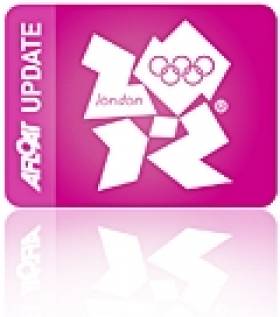Displaying items by tag: Star
Annalise Murphy is Ninth in World Cup Standings
Annalise Murphy is Miami Medal Prospect
The strong Dun Laoghaire girl relished the prospects of the big winds that blew at times on Biscayne Bay this week. Consistent results of 5, 15, 2, 2, 5, 6 11,9, (21) and 5 never saw her out of the top five.
Tuesday saw her bag two second places in a fleet of 58. It was a turning point in a regatta that she crashed out of last year only to return wth grit to be Ireland's only medal hope today.
Last night's move up to fourth overall on the scoreboard is another confidence boost, heightening the prospect of a place on this evening's podium. Conditions in Miami today are forcast to be light, probably not the conditions the National Yacht club girl would have hoped for.
In the Star Peter O'Leary and his crew for his London 2012 bid David Burrows finished with a strong fifth place yesterday but it was not enough to make today's final. They finished 13th overall after counting a black flag disqualification on day two of the event. See all results HERE.
Rival to Annalise, Tiffany Brien from Belfast Lough finished 21st overall.
Her club mate Jame Espey was 49th out of 52 after 7 races in the Laser gold fleet.
More from Miami organisers below:
Waking to a brisk northwesterly breeze, sailors at US SAILING’s Rolex Miami OCR yesterday made up for races lost to light air Wednesday. The conditions, though chilly by Florida standards, played out perfectly for medals to be determined in three Paralympic classes, while 10 Olympic classes fought their final battles for the right to compete in tomorrow’s medal races, which are comprised of top-ten “sail-offs” for Finn, 49er, Men’s 470, Women’s 470, Laser, Laser Radial, Men’s RS:X, Women’s RS:X and Star classes, and Finals and Petit Finals for Elliott 6m (women’s match racing). The regatta, which began Monday for 716 sailors from 53 nations, prepares Olympic and Paralympic sailing aspirants for the 2012 Games and is the second of seven stops on the International Sailing Federation (ISAF) Sailing World Cup circuit.
For France’s Damien Seguin, a two-time 2.4mR IFDS World Champion who is currently ranked #1 in the world, winning gold in the Paralympic 2.4mR class was looking good from day two when he assumed the lead over his 30-boat fleet. Clinching today, however, was not as straightforward as today’s scores seemed to reflect. Following seven boat lengths behind leader USA’s John Ruf (Pewaukee, Wis.) at the finish in race one, Seguin was determined the actual winner when Ruf was disqualified for starting the race prematurely and neglecting to exonerate himself. “After that, for my next two races, my score was such that I needed only to loosely cover Thierry Schmitter (NED),” said Seguin, further explaining that only if he finished worse than sixth would he foil his own plot. Schmitter, another IFDS World Champion, took the Silver Medal, finishing fourth in the first race and winning the next two, each time with Seguin behind in second.
“There were many different winds here,” said Damien about the practice this provides for his run for a spot on the French national team. “We started in strong wind, then there was light wind and today medium-strong. I am very happy for that and for the competition.”
Taking bronze was Canada’s Allan Leibel, who is able-bodied and allowed to compete here, since the class is declared “open” for this event.
The Gold Medal taking in the Paralympic Sonar class by GBR’s John Robertson/Hannah Stodel/Steve Thomas came with an intriguing twist today. With two races completed, the Dutch team of Udo Hessels/Mischa Rossen/Marcel van de Veen were in the lead, and surprisingly, they did not sail the third and final race.
“There were two points between us and the Dutch, so no one will ever know how it would have played out on the water,” said Robertson, explaining that he understands Hessel’s middle crew Rossen, a single-arm amputee, had been having problems with his opposite shoulder and the team had decided beforehand to race no more than two races today.
Robertson’s team, which took the Silver here last year, posted a final score of 30 to the 36 points posted by silver medalists Bruon Jourdren/Eric Flageul/Nicolas Vimont Vicary (FRA). The Dutch team, with 37 points, is going home with the Bronze.
As for his team’s overall strategy here, Robertson said, “We tried to sail our own race and not get hung up with the other guys. Hanna did a fantastic job calling tactics, especially today, as the wind was up and down and all over the place, with 40-50 degree shifts.”
The Australian Paralympic SKUD 18 team of Daniel Fitzgibbon/Liesl Tesch has led their fleet since day one and boasted six victories in their nine-race score line to take the Gold medal. Today they finished 1-1-2.
“We didn’t walk away with it, really, but we were comfortably ahead,” said Fitzgibbon, who won a Paralympic Silver Medal (with a different crew) in Qingdao. "We didn’t expect to have done so well with such a new combination,” he added, noting that he and Tesch, who gave up Paralympic basketball (she is a two-time medalist) for her new-found love of sailing, have only been together on the SKUD 18 for a few weeks. “It’s a new challenge for her and a breath of fresh air for everybody.”
Taking Silver was US Sailing Team AlphaGraphics’ Scott Whitman/Julia Dorsett (USA), with Alexandra Rickham/Niki Birrell (GBR) taking the Bronze.
Medal Races Tomorrow
Top-ten finishers from today in each of nine Olympic classes will get only one chance--a 30- to 40-minute race—to make or break their claim to a podium position. Emulating the Olympic format, the medal race counts double points and cannot be counted as the one allowed discard race when it is added to a sailor’s score line from the rest of the series.
In women’s match racing, US Sailing Team AlphaGraphics members Anna Tunnicliffe(/Molly Vandemoer/Debbie Capozzi (Plantation, Fla., USA/Redwood City, Calif./Bayport, N.Y., USA) will meet Claire Leroy/ Elodie Bertrand/Marie Riou (FRA) in a first-to-three points Finals match tomorrow to determine Gold and Silver medalists. Lucy Macgregor/Mary Rook/ Kate Macgregor (GBR) and Sally Barkow (Nashotah, WI., USA)/ Alana O’Reilly (Charleston SC, USA)/ Elizabeth Kratzig-Burnham (Miami Beach FL, USA) will be fighting for bronze in the Petit Finals.
Match racing starts on its own course at 9:30 tomorrow, with fleet racing starting at 11:00 am on two additional courses. Fleet races are planned to be approximately 30 minutes in length and started 40 minutes apart. No racing will start after 1:40 p.m., so it will be an early day.
US SAILING has partnered with the city of Miami to provide world-class venues for competition. Additional hosts for the event include Coral Reef Yacht Club, Key Biscayne Yacht Club, Coconut Grove Sailing Club, Miami Rowing Club and Shake-a-Leg Miami. These sailing organizations host classes onshore, as well as help run the on-the-water racing. The Coral Reef Yacht Club also hosts the Opening and Closing Ceremonies.
In addition to title sponsor Rolex Watch U.S.A., US SAILING’s 2011 Rolex Miami OCR is also sponsored by AlphaGraphics, Gowrie Group, Chubb Insurance, Sperry Top-Sider, Harken McLube, Trinity Yachts, University of Miami Hospital and Kattack.
A complete roster of competitors can be viewed at the event website, RMOCR.ussailing.org, where real-time racecourse blogging, commentary and fan interaction, regatta results, photos and news updates will be integrated into a live coverage platform once racing begins. Video highlights produced by Gary Jobson and presented by Rolex air daily and are available on-demand on the event website. Fans can also follow the event on Facebook/RolexMiamiOCR and Twitter/RolexMiamiOCR.
More in our Olympics 2012 category HERE
Miami Update: Star Pairing in 16th
Murphy Moves into Third in Miami
Two seconds in today's Laser Radial racing on Biscayne Bay give Dun Laoghaire's Annalise Murphy third overall at Miami Olympic Classes Regatta but the news in the Star class is not as good after Ireland's Peter O'Leary and David Burrows nosedive after a Black Flag Disqualification in race four.
Single hander Murphy, from the National YC, is racing in a highly competitive 58-boat fleet that is led by Belgium's Evi Van Acker. Winds over 16 knots ideally suited the National YC sailor wh now counts a 5, 15 and the two second places. Results HERE.
O'Leary and Burrows dropped from fourth to 23rd after counting a 28th and the Black Flag result today in their 56-boat fleet. Results HERE.

Annalise to leeward in a start in great conditions in Miami. Photo: Daniel Forster/Rolex
O'Leary and Burrows off to Flying Start in Miami
Ireland is off to a flying start at Miami Olympic Classes Regatta in the Star Class. Peter O'Leary and David Burrows lie fourth overall in a fleet of 58 boats. Former Laser ace Robert Scheidt and Bruno Prada from Brazil lead from Sweden's Frederick Loof and Max Salminen. Racing continues today. More HERE. Peter O'Leary podcast interview HERE.
Boats for Sale: Your Chance to Shine Among the Stars
Fancy having a crack at some of the top sailors in the world? They'll be here in Irish waters later this year competing for European honours in the Olympic Star keelboat class.
Olympic campaigner Max Treacy is selling a 1995 Star Boat with milled keel,
spars, sails, trailer and covers. It's ready to race against an expect fleet of 60 on Dublin Bay. The boat is posted on the Afloat boats for sale site for 9k. More HERE.
Update: O'Leary and Kleen Win Gold in Weymouth
Peter O'Leary and Frithjof Kleen have won gold for Ireland this afternoon at the Skandia Sail for Gold Regatta. The Irish -German duo left in their wake a string of world champions and Olympic medallists including Torben Grael, Robert Sheidt and the current Olympic Gold Medallists, Britain's Ian Percy and Andrew Simpson.
Dun Laoghaire's Annalise Murphy who raced in the medal race for the Laser Radial class has finished tenth overall. Results HERE.
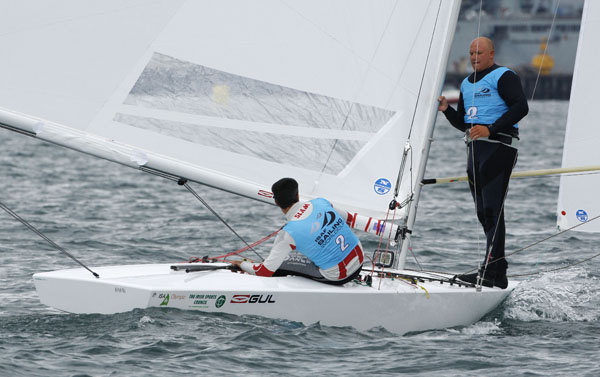
Australia went home laden with gold after an astonishing week of racing in Weymouth Bay – the 2010 Olympic venue. The Aussies picked up gold in four classes; Nicky Souter, Nina Curtis and Olivia Price in the Women's Match Racing, the Skud-18 was won by Daniel Fitzgibbon and Rachael Cox on Friday, Tom Slingsby took gold in the Laser Men, and Nathan Outteridge and Iain Jensen made up the top quartet with a win in the 49er class.
The French team pushed Australia all the way, with three gold medals – Pierre Leboucher and Vincent Garos won the 470 Men, Charline Picon took gold home in the RS:X Women, and in the 2.4mR, it was Damien Seguin who did the business for France. The Dutch team then edged the home nation out of the gold medal table with wins in two classes, Marit Bouwmeester in the Laser Radial and Udo Hessels, Marcel van de Veen and Mischa Rossen in the Sonar. While Team Skandia GBR were left with a single gold, which was Giles Scott in the Finn. The consolation for the most successful Olympic sailing nation of the last three Olympiads was a hatful of silver and bronze – two silver and four bronze.
The venue, Weymouth and Portland National Sailing Academy is the 2012 Olympic venue and it threw everything at the competitors this week – saving the best for last, with a medal race day that was the best of the British summer; wind, rain, calms and even a little sunshine right at the end. The huge entry of 975 sailors from 57 nations spread across 712 boats in 13 classes will go home having learned to expect the unexpected in August 2012.
Ireland Guaranteed Medal in the Star Class Today (Podcast here)
Ireland is guaranteed a medal today at the British Skandia Sail for Gold regatta in the Star class but Peter O'Leary's clean run in the keelboat this week was not without drama yesterday when his crew Fritjof Kleen slipped overboard 300 metres from the finish line.
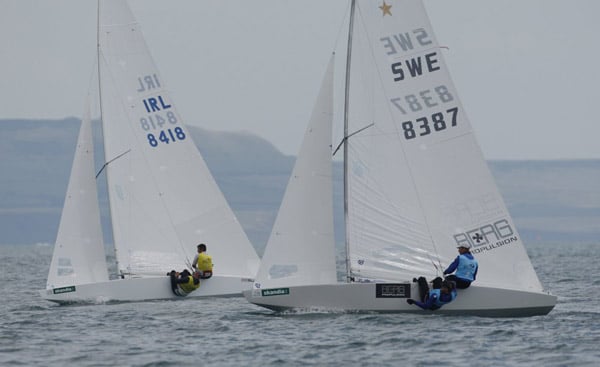
Peter O'Leary and Frithjof Kleen (IRL) against Fredrik Loof and Johan Tillannder (SWE) in the Star class on day 5 of the Skandia Sail for Gold Regatta. Photo: onEdition
Ireland Racing for Medals in Star and Laser Radial
Ireland races in two medal races tomorrow at the Skandia Sail for Gold Regatta following strong performances by its Olympic squad across dinghy and keelboat classes. Annalise Murphy is ninth and on her way to a convincing overall performance but by far and away the stand out story in Weymouth this week has come from Royal Cork's Peter O'Leary whose speed in the Star class has beaten the very best in the world bar none. He lies at the top of the leaderboard tonight seven points clear, an achievement made all the more remarkable because he sailed with a standby crew, German sailor Fritjof Kleen, without any pre event practice.
Today we saw the gold fleets split off. The majority of the sailors were dispatched to silver and bronze fleets – with no more chance at the podium. But if that was a deep cut, then the next will hurt even more, as many top seeds have just one more day to rescue themselves. Tomorrow night the top ten will be decided for Saturday's medal races, and if you have to be in it to win it.
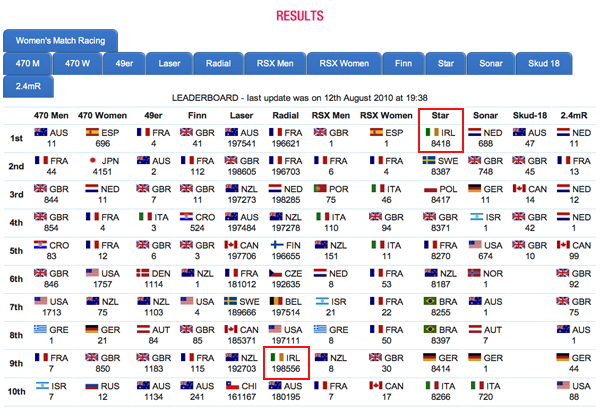
The leaderboard tonight at the Skandia Sail for Gold Regatta showing Ireland in the hunt for two medals
The 470 Women have been brutally competitive all week, as we highlighted yesterday. No less so today, where the Dutch World Champions and overnight leaders Lisa Westerhof and Lobke Berkhout dropped to third - the Spanish team of Tara Pacheco and Berta Betanzos are now taking the top spot. The situation is even worse for the Danish team that was third overall in the ISAF Sailing World Cup going into this regatta - Henriette Koch and Lene Sommer are currently lying 12th - over the edge for the medal race if they can't pick up a couple of places tomorrow.
There's another big name in trouble in the 470 Women and that's double Yngling gold medallist Sarah Ayton and her crew Saskia Clark, now in 18th and 31 points adrift of the medal race. But e can't leave the 470s without some good news, and a mention for an outstanding performance today from Americans Erin Maxwell and Isabelle Kinsolving, who scored two bullets. The 470 Men were a little more predictable, with World Champions Matt Belcher and Malcom Page ascending to the top of the leaderboard, and none of the top seeds looking like missing the cut.
In the Stars, there were some very familiar names around the medal race cut - Szabo and Strube in 10th, Mendelblatt and von Schwarz in 11th (they were looking for a podium in the ISAF SWC going into this regatta), Marazzi and de Maria in 12th (second placed at the 2010 Worlds), Negri and Voltolini in 13th, Rohart and Ponsot in 14th, Campbell and Funk in 16th, Horton and Lynne (also looking for a podium in the ISAF SWC) - and on it goes, but I guess that's the Star fleet for you... O'Leary and Frithjof Kleen still control the fleet with a seven point lead. O'Leary's rivals Max Treacy and Anthony Shanks who were 25th overall did not compete in either race today.
I guess the most worried man in the Finn fleet right now would be Rafael Trujillo. The Spanish silver medalist (Athens, 2004) was on form at the Europeans with a fourth, but is currently lying in 14th and staring the cut for the medal race in the face. The outstanding performer in that fleet today was the Brit... no, not Ben Ainslie, but Giles Scott. Scott scored a second and a third to go to the top of the scoreboard, pushing aside the long-time leader, Frenchman Jonathan Lobert.
In the 49er the Brits, John Pink and Rick Peacock, were second at the Worlds in 2009, but are struggling just below the cut in 11th - a good day tomorrow should get them through. Also in trouble are the top guys in the ISAF Sailing Cup, so we could see that settled early. Leading the SWC into this regatta was Nico Luca Marc Delle Karth and Nikolaus Leopold Resch, who look safe in eighth place tonight. But chasing them was Allan Norregaard and Peter Lang who may not make it into the medal race, currently 12th. That would play into the hands of SWC third placed Manu Dyen and Stephane Christidis – the Frenchmen are still leading Skandia Sail for Gold.
In the RS:X MEN, the Beijing gold medallist and 2008 World Champion, New Zealander, Tom Ashley is close to the drop, in ninth place after an eighth and an eleventh today. Otherwise it was service as usual, with the top seeds in good shape. Britain's Athens Bronze medallist, Nick Dempsey still leads overall by four points. Things are all also going according to plan in the RS:X Women, where none of the seeds are in danger. The Spanish sailor and last year's Skandia Sail for Gold Champion, Blanca Manchon, retains her lead.
In the Laser Radials it's Tatiana Drozdovskaya from Belarus who's in trouble - fifth at the worlds and currently lying 15th. The top American sailor, Page Railey is also in a bit of trouble in eighth, but she helped her cause no end with a second this afternoon. Another Radial sailor that got themselves out of danger was today's outstanding performer, Sari Multala – the 2010 World Champion and last years Skandia Sail for Gold winner sailed beautifully to get a fourth and a first and move up to fifth.
The Laser Men were last on the water, and full results were not published when we went to press (as they used to say in the good old days). But names to watch that are near the drop zone for the medal race cut are the UK's Nick Thompson, second in the ISAF Sailing World Cup going into this regatta. And from Chile, Matias Del Solar, France's Jean Baptiste Bernaz, Spain's Javier Hernandez and Austria's Andreas Gertizer were all struggling. Australia's Tom Slingsby, winner here last year, was leading overall – by a long way.
There are four fleets that are unconcerned by the threat of the cut for the medal race, and one of them is the Women's Match Racing, now at the quarter final stage. It got exciting very quickly when the round robin produced a QF between the ISAF Sailing World Cup's overall leader, Great Britain's Lucy and Katie MacGregor and Annie Lush, and the US team just one point behind them – Anna Tunicliffe, Molly Vandemer and Debbie Capozzi. Victory for either would put the other out of the running for the ISAF SWC title. And it was the Americans that held the advantage at the end of play – 2 – 0 up, and with Macgregor receiving a -0.75 penalty for damage done in a collision.
We talked to Lucy Macgregor afterwards, "I'm pretty gutted really [that the two Quarter Final matches out there didn't go to plan]... The next match is really crucial; it's the first to three points so we will be having a good night's rest, coming back fighting in the morning and putting everything into it. They didn't let us get away with anything out there - positionally they were good, but we felt pretty strong against them around the course, so really gutted to come away with a 2- 0 defeat."
And Anna Tunnicliffe had this to say afterwards, "Lucy's a great competitor and we still have plenty of racing ahead of us. We put ourselves in a good position [for a Semifinal spot] and tomorrow's a new day, so hopefully we will continue. It was very tricky sailing out there, very shifty, very puffy, the boat behind downwind had very powerful control of the race and Lucy always ran behind us and made it really hard on us."
Three other classes finish their regatta tomorrow without the complication of a medal race. So we really are at the business end of the regatta for the Skud-18s, where the Australian pair of Daniel Fitzgibbon and Rachael Cox have been battling with GBR's Alexandra Rickham and Niki Birrel. The pair had traded first and second places until the final race of today, when Rickham and Birrel had a rudder problem and were forced to retire. It's given the Aussies a four point advantage going into the final day.
In the Sonar class, the Dutch high-fliers, Udo Hessels and Mischa Rossen once again had their wings clipped by the British team of John Robertson, Hannah Stodel and Stevie Thomas. The Brits had a great day with two thirds and a win, and are now just one point off the lead. Hannah Stodel said afterwards, "Today has not been too bad we had a second and a first, which has made the points very interesting, as we were four behind the Dutch but it looks like they had an average day. I am not sure if we are first, but it will be tight, the conditions were shifty and pretty exciting today, luckily it's our favourite condition... random!"
In the 2.4mR, France's Damien Seguin and the Netherlands Thierry Schmitter continued their week long battle. Schmitter had got the advantage going into the final race, but then slipped to fifth, allowing Seguin to take back the overnight lead – this one looks like it will be settled in the final beat of the final race.
(results conditional on protests)
470 Woman Results (After eight races)
1st Pacheco and Betanzos ESP 43 points
2nd Kondo and Tabata JPN 45 points
3rd Westerhof and Berkhout NED 49 points
4th Petitjean and Douroux FRA 53 points
5th Rol and Defrance FRA 57 points
470 Men Results (After eight races)
1st Belcher and Page AUS 20 points
2nd Leboucher and Garos FRA 21 points
3rd Patience and Bithell GBR 31 points
4th Asher and Willis GBR 33 points
5th Fantela and Marenic CRO 38 points
49er Results (After ten races)
1st Dyen and Christidis FRA 28 points
2nd Outteridge and Jensen AUS 30 points
3rd Morrison and Rhodes GBR 36 points
4th Sibello and Sibello ITA 47 points
5th Draper and Greenhalgh GBR 52 points
Finn Results (After eight races)
1st Scott GBR 31 points
2nd Lobert FRA 32 points
3rd Wright GBR 40.3 points
4th Kljakovic Gaspic CRO 44 points
5th Ainslie GBR 45.4 points
Laser Results – (After eight races)
1st Slingsby AUS 11 points
2nd Leigh CAN 42 points
3rd Goodison GBR 50 points
4th Murdoch NZL 55 points
5th Tom Burton AUS 59 points
Laser Radial Results (After seven races)
1st Steyaert FRA 24 points
2nd De Turckheim FRA 26 points
3rd Bouwmeester NED 27 points
4th Winther NZL 29 points
5th Multala FIN 34 points
RS:X Men Results (After eight races )
1st Dempsey GBR 18 points
2nd Bontemps FRA 22 points
3rd Van Rijsselberge NED 26 points
4th Tobin NZL 27 points
5th Rodrigues POR 27 points
RS:X Women Results (After eight races)
1st Manchon ESP 26 points
2nd Picon FRA 35 points
3rd Tartaglini ITA 40 points
4th Shaw GBR 41 points
4th Linares ITA 46 points
Star results – (After eight races)
1st O'Leary and Kleen IRL 28 points
2nd Loof and Tillander SWE 38 points
3rd Kusznierewicz & Zycki POL 42 points
4th Percy and Simpson GBR 45 points
5th Florent and Rambeau FRA 46 points
Women's Match Racing
Quarter Final 1
Souter, Curtis and Price AUS and Kjelleberg, Kallstrom and Harryson SWE tied 1-1
Quarter- final 2:
Leroy, Riou and Bertrand FRA and Spithill, Eastwell and Farrell AUS tied 1-1
Quarter -final 3:
Renee Groeneveld, Annemieke Bes, Brechtje van der Werf and Sally Barkow, Alana O'Reilly, Genny Tulloch tied 1-1
Quarter -final 4:
Tunicliffe, Vandemer and Capozzi USA leads Macgregor, Lush and Macgregor GBR 2- -0.75 (0.75 points deducted from Macgregor for damage)
2.4mR Results – (After eight races)
1st Damien FRA 11 points
2nd Schmitter NED 11 points
3rd Kol NED 22 points
4th Tingley CAN 32 points
5th Pascoe GBR 42 points
Skud-18 Results – (After eight races)
1st Fitzgibbon and Cox AUS 8 points
2nd Rickham and Birrell GBR 12 points
3rd McRoberts and Hopkin CAN 20 points
4th Hovden and Millward GBR 27 points
5th Hall and Faulks GBR 33 points
Sonar Results – (After eight races)
1st Hessels and Rossen NED 14 points
2nd Robertson and Stodel GBR 15 points
3rd Kroker and Prem GER 21 points
4th Cohen and Vexler ISR 26 points
5th Doerr and Freund USA 31 points
Big Breeze Brings Big Results in Weymouth
Peter O'Leary and newly adopted German crew Frithjof Kleen were winners in the single Star keelboat race today but only after an international jury granted redress to the Cork helmsman who crossed the line second at the Skandia Sail for Gold regatta in Weymouth this afternoon. A second win for Ireland was secured in the big breeze by Annalise Murphy in the Laser Radial class who also scored second in this morning's race, rounding off a successful day for the 11 strong Irish crew off the Portland Bill. Below is a podcast update from Team Manager James O'Callaghan as the crews came off the water this evening.
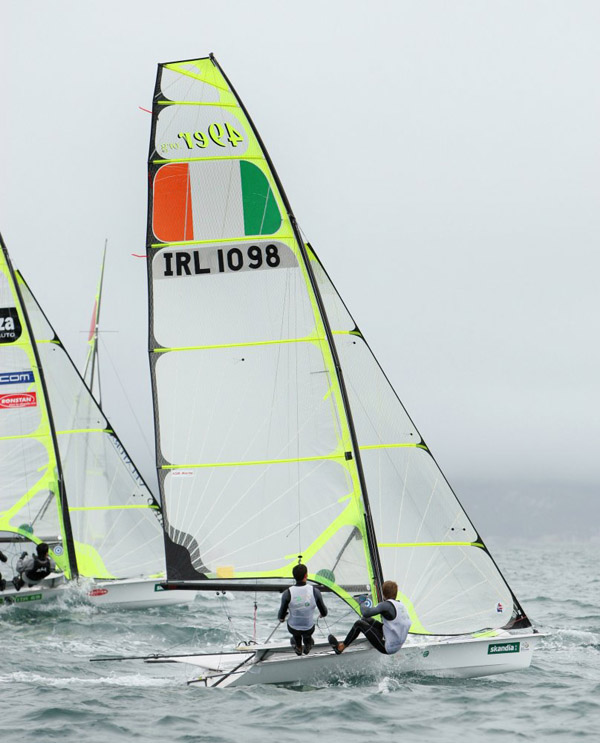
(Above) Ed Butler and Ben Lynch (IRL) in action in the 49er class on day 2 of the Skandia Sail for Gold Regatta and (below) Saskia Tidey in the Laser Radial . Photo OnEdition
